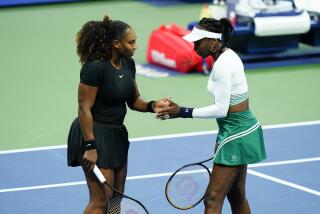Hingis’ History Suggests Crisis Will Be Solved
- Share via
CARLSBAD, Calif. — Martina Hingis came to Spa Land in the midst of a Generation Y career crisis, dismissed as an overnight has-been and criticized for her lackluster attitude.
In 1998.
For all the intense focus on her recent problems, it should not be forgotten that this event was a seminal point for her last year. Hingis had not won a tournament since the Italian Open in early May, and her malaise deepened when she blew three match points and lost to Mary Pierce in the semifinals at the La Costa Resort and Spa.
Melanie Molitor, Hingis’ mother and coach, told her daughter that she “played like a junior.” Subsequently, Hingis pulled it together, reaching the final at Manhattan Beach and the U.S. Open, finishing the year ranked No. 2.
Which is why Hingis chuckled the other day when asked about her latest lapse in confidence, the much-ballyhooed “career in crisis” prompted by her successive defeats in Paris and London.
“Last year, here,” she said. “It’s always the same steps. Two times in a row. But I think I was [feeling] lower last year.”
After her French Open meltdown in the final against Steffi Graf, Hingis played one match--and lost to Jelena Dokic at Wimbledon--before coming here. The hot-house atmosphere of Wimbledon and temporary split with her mother ratcheted up the scrutiny.
It was, after all, one bad match.
“You always have some stage of your career,” Hingis said. “I don’t think it’s the first or last time. I’m not saying I’m over the hill. I feel better now again.”
After all the angst and woman-on-the-verge- of-a-tennis-breakdown discussion, Hingis will leave Carlsbad as the top player in the world. Saturday, she reclaimed No. 1 from Wimbledon champion Lindsay Davenport. She does know how to get the ranking back from Davenport, having done it once before in February.
This time, Venus Williams set the process in motion by defeating Davenport in the semifinals of the TIG Tennis Classic Saturday afternoon. All Hingis needed was a 6-1, 6-2 victory against Amanda Coetzer of South Africa in the night semifinal.
Hingis said she has “grown” in the last few weeks. Finally, the 18-year-old seems much closer to recognizing her shortcomings.
“I want it more,” she said. “I didn’t do that well, and I just want to do better. I missed it, and missed not being one of the best players in the world. I’m used to that. I didn’t want to be a loser, somebody around the court who can’t play tennis.”
For all her 1999 difficulties, Hingis remains the only player on the tour to reach two Grand Slam finals this year. She defeated Amelie Mauresmo to win the Australian Open and lost to Graf in the French final. Davenport has the next best showing, winning Wimbledon and reaching the Australian Open semifinals.
“I don’t want to be like I can only win the Australian Open and nothing else,” Hingis said.
In 1997, Hingis won three of the four Grand Slams at 16. Afterward, Hingis acted as though she was entitled to that kind of showing every year. Now, she knows differently.
“It just was out there and came easy, I was playing well,” she said. “I don’t think I understood what was going on. I didn’t really appreciate it because it was so easy, in a way. My head, my body, everything was easier at that time.
“In ‘97, there was a time when the older players weren’t so good. They weren’t working hard. Steffi wasn’t there. She was injured all the time. The youngsters, they were not as good yet. I just had an open road in a way. I just kept playing Monica [Seles], Monica and Monica over again. She was the only real rival for me.”
That changed in 1998 and 1999, even though she won five tournaments last year and four this year.
“I know I’ve won five Grand Slams, I shouldn’t be nervous,” Hingis said “Still, you [wonder] if you can do it again, if you can beat those players you used to beat.”
Humility has never been a word associated with this current crop of teen-aged female tennis players. The kids, quite possibly, may be growing up . . . albeit slowly.
NOTABLE
* The ankle injury suffered by Australian teenager Lleyton Hewitt in his quarterfinal match against Andre Agassi at the Mercedes-Benz Cup in Los Angeles is more serious than first believed.
Australian Davis Cup captain John Newcombe is worried about the availability of Hewitt and Mark Philippoussis for the Davis Cup semifinal against Russia in September. Philippoussis, who was injured in his Wimbledon match against Pete Sampras at Wimbledon, had knee surgery and has not returned to action.
Hewitt pulled out of Montreal and Cincinnati. Also not playing this week at Cincinnati are Greg Rusedski (injured toe), Karol Kucera (wrist), Marcelo Rios (hip) and Felix Mantilla, who is ill.
* At this week’s Acura event in Manhattan Beach, the three wild-card entries are Wimbledon semifinalist Alexandra Stevenson, Corina Morariu and Iva Majoli. Stevenson could meet Davenport in the second round but has a difficult first-round test against Anke Huber of Germany.
Davenport and third-seeded Pierce are in the upper half of the draw, and second-seeded Hingis and sixth-seeded Serena Williams could meet in the semifinals, a rematch of their quarterfinal meeting last year.
More to Read
Go beyond the scoreboard
Get the latest on L.A.'s teams in the daily Sports Report newsletter.
You may occasionally receive promotional content from the Los Angeles Times.











